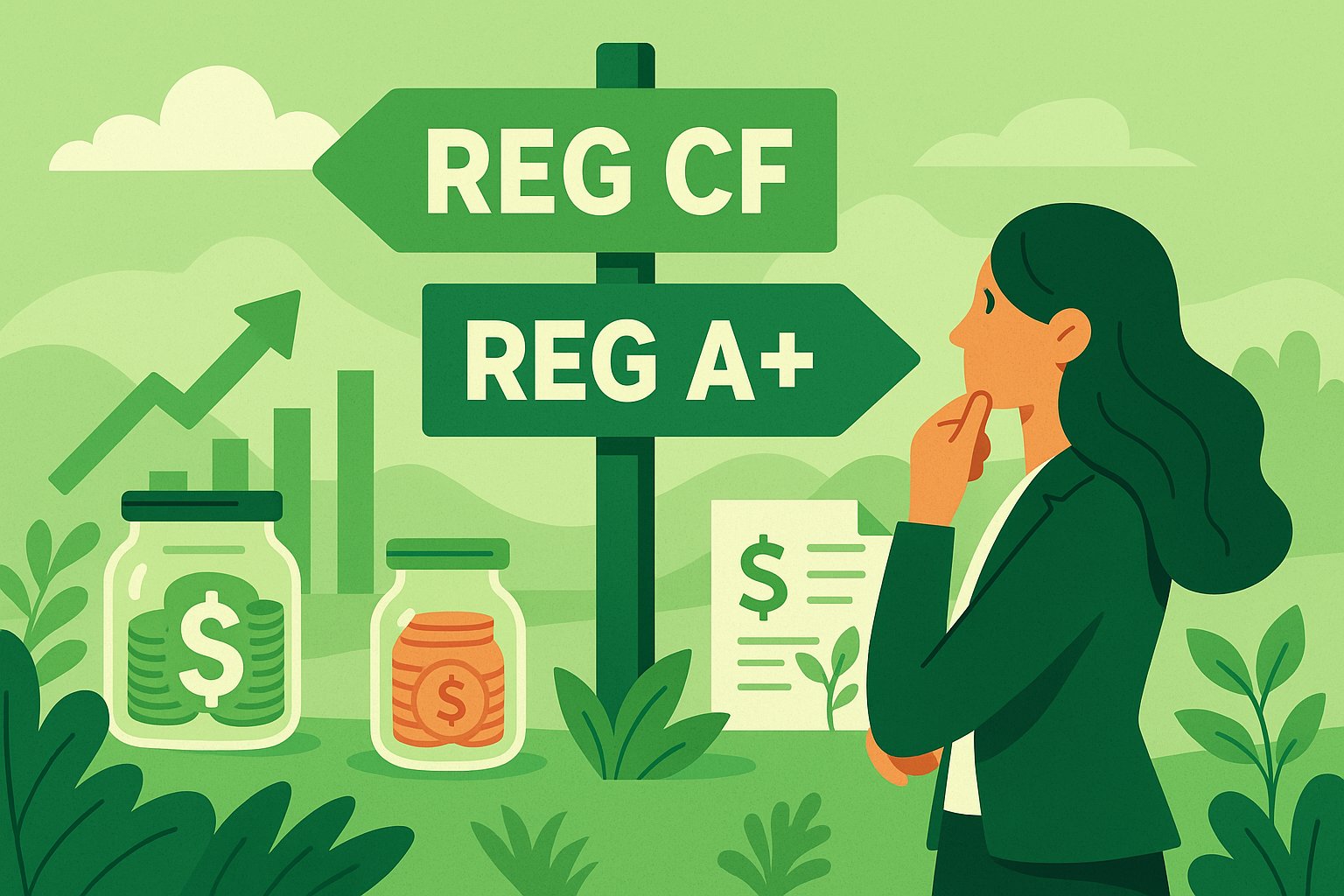Balancing Opportunity and Compliance: Choosing Between Reg CF and Reg A+ for Your Raise
Launching a successful fundraising campaign demands more than just a compelling pitch and a visionary team; it requires a deep understanding of the regulatory pathways that govern how you engage investors and deploy capital. In 2025’s dynamic funding environment, two securities exemptions stand out for growth-stage companies: Regulation Crowdfunding (Reg CF) and Regulation A+ (Reg A+). Each offers unique advantages—Reg CF democratizes access to capital by welcoming both accredited and non-accredited investors online, while Reg A+ scales up offerings to tens of millions of dollars with options for broader public participation and deeper liquidity. Yet these pathways differ drastically in capital limits, disclosure obligations, investor eligibility, marketing freedoms, and ongoing reporting requirements, making the choice between them a strategic crossroads. For founders determining whether to launch a splashy Reg CF campaign full of grassroots buzz or to pursue a more traditional Reg A+ raise that positions their company for secondary trading, the stakes are high. Choosing the wrong exemption can lead to excessive costs, compliance missteps, or missed growth opportunities. This guide unpacks all facets of Reg CF and Reg A+, equipping you with a clear decision-making framework that aligns with your business stage, target investors, and long-term capital strategy.
Understanding Regulation Crowdfunding (Reg CF) Fundamentals
Regulation Crowdfunding, enacted under Title III of the JOBS Act, empowers companies to raise up to $5 million annually by selling securities through SEC-registered funding portals or broker-dealers. At its core, Reg CF is designed to lower barriers for both small businesses and Main Street investors. For companies, the minimal check sizes—sometimes as small as $100—open the door to vibrant community engagement, turning customers into backers and brand advocates. Portals handle identity verification, subscription processing, and basic compliance checks, enabling even first-time issuers to navigate fundraising without building an entire internal infrastructure. Yet with this simplicity comes a prescribed set of rules: issuers must file a Form C offering statement detailing financials, business descriptions, and material risks; investors face annual caps based on income or net worth; and campaigns must update investors at least annually or upon material events. By providing a turnkey online platform, Reg CF thrives on speed, storytelling, and retail buzz, making it ideally suited for consumer brands, early-stage technology ventures, and social enterprises seeking both funds and grassroots momentum.
Exploring the Power of Regulation A+ (Reg A+)
Regulation A+ represents a hybrid between private placements and full public offerings, allowing companies to raise up to $75 million in a 12-month period under Tier 2, or up to $20 million under Tier 1. Unlike Reg CF, Reg A+ offerings can target a national audience—accredited and non-accredited investors alike—without yearly caps on individual contributions (though non-accredited investors face limits when raises exceed $20 million). The exemption preempts state blue-sky laws for Tier 2, streamlines the SEC registration process via Form 1-A, and demands audited financial statements alongside ongoing reporting obligations. A successful Reg A+ campaign positions shares for potential trading on alternative trading systems, laying the groundwork for real liquidity. For companies with proven revenue streams, robust governance practices, and a desire for substantive capital infusions, Reg A+ blends the brand-building benefits of a public offering with a cost structure more accessible than a traditional IPO. While the legal, accounting, and marketing investment is higher, the scale, credibility, and exit opportunities often justify the extra rigor.
Matching Fundraising Caps to Your Growth Goals
Determining how much capital you need—and how quickly you need it—is the first filter in choosing between Reg CF and Reg A+. If your seed-stage startup requires a few hundred thousand dollars to refine a prototype, build initial traction, or fund a limited pilot program, Reg CF’s $5 million cap offers more than enough runway. The low minimum checks and portal support further accelerate small raises. Conversely, if you’re entering a hyper-growth phase—expanding into new regional markets, scaling manufacturing capacity, or launching a multi-year marketing campaign—and require $10 million or more, Reg A+ becomes the logical choice. The ability to access broader investor pools without incremental compliance per state, and to position your shares for trading post-qualification, ensures your capital structure can support large-scale initiatives. Recognizing that capital needs evolve, some companies leverage both exemptions sequentially: beginning with a Reg CF round to validate market demand, then transitioning to a Reg A+ raise to secure institutional-scale financing.
Weighing Investor Eligibility and Community Engagement
A core distinction between Reg CF and Reg A+ lies in investor demographics. Reg CF campaigns welcome all investors—subject to annual contribution caps tied to personal income or net worth—fostering a community of brand enthusiasts and retail backers. This inclusivity accelerates social media buzz, word-of-mouth referrals, and customer loyalty, but can also result in managing hundreds or thousands of small positions and ensuring each investor receives mandated disclosures. Reg A+ Tier 2 offers similar broad access but removes per-investor annual caps, inviting high-net-worth individuals, family offices, and accredited investors to participate at any check size. Tier 1, though lower in maximum raise, still permits both accredited and non-accredited investors but requires state-by-state compliance. For founders who see their investors as strategic partners—bringing domain expertise, distribution channels, or co-investment potential—Reg A+’s more flexible check sizes and layered investor protections may yield deeper relationships that transcend the typical crowdfunding backer dynamic.
Navigating Disclosure Obligations and Reporting Cadence
Both Reg CF and Reg A+ demand transparency, but the depth and frequency of required disclosures differ substantially. Reg CF issuers file Form C, disclosing business models, financial condition, ownership structure, and material risks. Financial statements range from unaudited tax returns for small raises to reviewed or audited statements for larger campaigns, and subsequent Form C-U updates are required annually or upon major developments. While portals help standardize these filings, founders must maintain discipline in gathering and updating data. Reg A+ Tier 1 shares require two years of financials, which may be unaudited, and once qualified, issuers must provide ongoing state-level notices. Tier 2 carries the most rigorous standard: audited financial statements, annual and semiannual SEC reports, and prompt current event disclosures on Form 1-UZ. Investors value this level of rigor, particularly when raises exceed $20 million, as it reduces asymmetry of information and enhances secondary market confidence. Founders must therefore allocate resources for in-house or external teams to manage accounting, legal reviews, and report preparation over multiple years.
Comparing Marketing and Solicitation Strategies
Crafting a compelling fundraising narrative is essential regardless of exemption, but marketing restrictions shape how you reach your audience. Reg CF relies on your chosen funding portal’s ecosystem—leveraging built-in email blasts, social integrations, campaign widgets, and live pitch events. General solicitation is permitted, provided materials link back to the portal and adhere to SEC disclaimers. The portal’s algorithm may boost campaigns that gain early traction, enabling rapid visibility growth. In contrast, Reg A+ “testing the waters” provisions allow issuers to gauge investor appetite before filing, using press releases, roadshows, and targeted digital ads—so long as they include specified disclaimers. Once qualified, general solicitation nationwide is fully permitted, offering the freedom to conduct a multiplatform marketing blitz encompassing podcasts, industry conferences, and mainstream media. The trade-off lies in navigating broker-dealer or issuer-direct channels, coordinating more complex outreach, and ensuring every touchpoint remains compliant with SEC guidance.
Assessing Cost Structures and Timeline Realities
No fundraising path is cost-free, and balancing expenses against net proceeds is critical. Reg CF’s portal fees—commonly 5 to 7 percent of funds raised—and payment processing charges are transparent but can significantly erode small-raise economics. Legal and accounting fees for Reg CF range from $20,000 to $50,000, depending on financial statement requirements. Campaigns can launch within weeks once materials are ready, speeding capital access. Reg A+ demands a larger upfront investment: legal fees for drafting the offering circular and navigating SEC comments often fall between $150,000 and $300,000, while accounting for audits and ongoing reporting can add another $75,000 to $150,000 annually. Marketing budgets for nationwide outreach and “testing the waters” communications can run $100,000 or more. Qualification timelines typically span four to nine months, depending on SEC review cycles and state blue-sky filings for Tier 1. Founders must therefore forecast runway needs accurately and align capital timing with business milestones.
Exploring Liquidity and Secondary Market Dynamics
Liquidity considerations frequently tip the scale when raising significant capital. Reg CF securities carry a one-year transfer restriction under SEC rules, though certain platforms facilitate limited peer-to-peer trading within their investor networks. Secondary market volumes tend to be modest, making large-scale exits challenging. Reg A+ Tier 2 shares, once qualified, may list on alternative trading systems, offering earlier liquidity windows and market-driven price discovery. Some issuers negotiate arrangements with market makers to support orderly trading, while others plan tender offers or share buybacks to provide structured exit options. For investors who demand timely access to their gains—and for founders who wish to profile their company’s stock price as a barometer of market sentiment—Reg A+ delivers superior liquidity prospects, reinforcing its appeal for growth rounds seeking deeper market validation.
Aligning Choice with Business Stage and Strategy
Your startup’s lifecycle stage and strategic objectives should inform the exemption you select. Early-stage companies with minimal revenue and a strong community following benefit from the agility and cost-effectiveness of Reg CF, as it catalyzes product feedback loops and brand advocacy alongside capital infusion. Growth-stage or scale-up ventures with proven business models, existing governance infrastructure, and executive leadership ready to engage institutional investors are primed for Reg A+ Tier 2, leveraging its higher ceilings and ongoing reporting to build credibility with high-net-worth individuals, family offices, and strategic partners. Tier 1 may serve as an intermediate step for companies seeking a moderate raise and local market engagement without the full audit burden of Tier 2. By anchoring your decision in your current traction, target raise amount, and long-term path to liquidity, you ensure regulatory structures support rather than hinder your growth trajectory.
A Step-by-Step Decision Framework
Selecting between Reg CF and Reg A+ requires a systematic approach. Begin by articulating your capital needs and timing constraints. Map your investor targets and anticipated check sizes, noting whether community engagement or large strategic backers are more critical. Conduct a cost-benefit analysis that tallies legal, accounting, platform, and marketing expenses against net proceeds under each exemption. Evaluate your readiness to meet ongoing reporting obligations and secondary market aspirations. Consult with securities counsel to identify any disqualifying factors—such as prior enforcement actions or unsuitable corporate structures—that might complicate one pathway. Finally, pilot small-scale “testing the waters” communications for Reg A+ to gauge institutional interest, or initiate preliminary outreach on Reg CF portals to assess retail buzz. This iterative due diligence ensures you choose the regulatory regime most aligned with both short-term milestones and long-term equity strategies.
Best Practices for Execution and Compliance
Whatever exemption you select, rigorous project management and compliance governance are non-negotiable. Assemble a cross-functional fundraising team—including legal counsel, accountants, portal or broker-dealer contacts, and marketing specialists—to coordinate deliverables, track SEC milestones, and manage investor communications. Implement a central repository for all offering materials, subscription documents, and investor inquiries to ensure audit-readiness. Leverage compliance software to monitor investor accreditation statuses, manage transfer restrictions, and schedule recurring reporting deadlines. Establish a cadence of internal check-ins—weekly during active campaign phases and quarterly thereafter—to surface and resolve any compliance gaps promptly. Clear documentation of processes and decision points not only satisfies regulators but also provides a roadmap for future raises, reducing friction and building institutional memory within your organization.
Charting Your Capital-Raising Journey
Choosing between Regulation Crowdfunding and Regulation A+ is far more than a legal formality—it is a strategic decision that shapes your company’s investor profile, growth trajectory, and governance model. Reg CF’s portal-driven, retail-focused framework excels at building community momentum with modest checks and rapid launch timelines. Regulation A+ offers the scale, credibility, and liquidity pathways necessary for companies on the brink of major expansion, albeit at higher cost and complexity. By aligning your fundraising exemption with your stage of development, capital requirements, and long-term exit aspirations, you position your business to seize market opportunities while maintaining unwavering compliance. Armed with the insights and decision-making framework outlined in this guide, you can navigate the regulatory crossroads with confidence—launching a raise that not only fuels growth, but also lays a solid foundation for your company’s future in the public and private markets.




